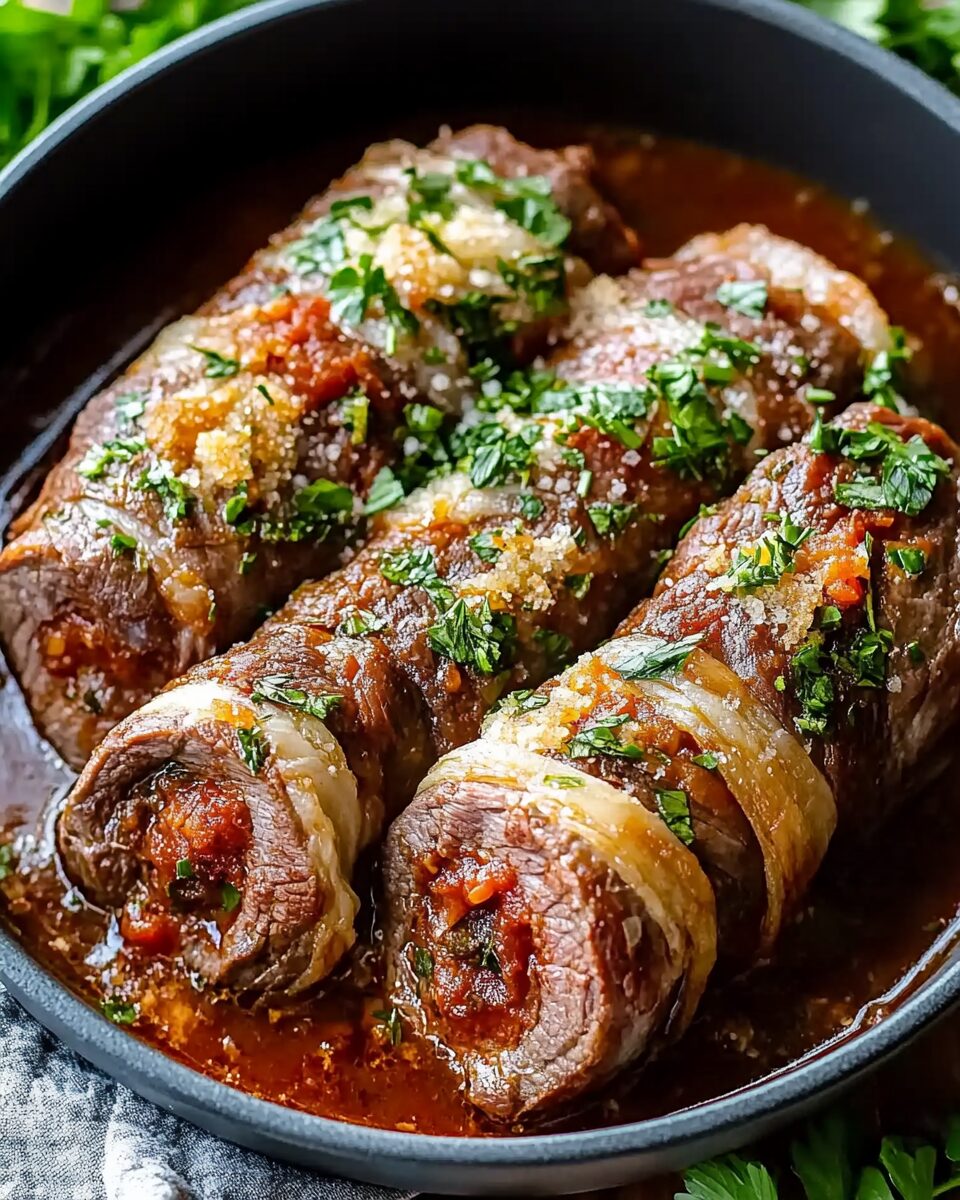What Is Braciole and Why Is It So Special
Braciole is made by taking thin slices of beef—often flank steak or top round—and filling them with a seasoned mixture of breadcrumbs, garlic, cheese, and herbs. The beef is then rolled tightly, secured with twine or toothpicks, seared until golden, and slowly simmered in tomato sauce until it becomes meltingly tender. What makes Braciole truly special is its ability to take simple, inexpensive ingredients and elevate them into a dish that feels luxurious and deeply satisfying. Every bite is packed with flavor, from the garlicky interior to the tomato-soaked exterior, making it a meal that feels both rustic and refined.
A Symbol of Italian Family Traditions
In many Italian and Italian-American homes, Braciole is more than just a meal—it’s a tradition. Often reserved for Sunday dinners or holidays, it’s a dish that invites slow cooking, family participation, and plenty of stories around the table. The process of pounding the meat, mixing the filling, and rolling each piece with care is almost therapeutic, often passed down from one generation to the next. This dish embodies the essence of comfort food: hearty, homemade, and made with love. It’s no surprise that Braciole often appears on menus during special family gatherings, where food is meant to nourish both body and soul.
The Filling: Simple, Savory, and Flavorful
The filling in Braciole is where the magic begins. A traditional blend of fresh breadcrumbs, grated Parmesan cheese, minced garlic, and chopped herbs like parsley and basil comes together to create a savory paste that adds both flavor and texture. The cheese brings umami and richness, the herbs offer freshness, and the breadcrumbs act as a binder while soaking up the juices during cooking. You can customize the filling with ingredients like pine nuts, raisins, or prosciutto for regional variations, but even the most basic combination delivers incredible depth when paired with tender beef and tomato sauce.
How Braising Transforms the Dish
Braising is key to the transformation of Braciole. After the beef rolls are seared to a golden brown, they are slowly simmered in a flavorful tomato sauce that not only tenderizes the meat but also infuses it with deep flavor. As the rolls cook low and slow, the connective tissue in the beef breaks down, resulting in a fork-tender texture that practically melts in your mouth. The sauce thickens as it simmers, absorbing the savory juices from the meat and the aromatic notes from the filling. It becomes more than just a sauce—it becomes a rich, velvety element that ties the entire dish together.
Choosing the Right Cut of Beef
For Braciole, flank steak and top round are the most commonly used cuts. These lean, somewhat tougher cuts are ideal for slow cooking, as they become tender and flavorful after braising. Pounding the meat to an even thickness is essential, not only to help with rolling but also to ensure even cooking. When properly prepared and cooked, these cuts offer the perfect balance of texture and flavor. They hold their shape well during the rolling and cooking process while soaking up all the delicious flavors of the sauce and filling.
The Importance of Tomato Sauce
The tomato sauce used in Braciole plays an integral role in the final flavor and presentation of the dish. A good sauce acts as a cooking liquid, flavor infuser, and serving base all in one. Made from crushed or pureed tomatoes and seasoned with garlic, onion, and herbs, the sauce gains complexity as it simmers with the beef. Its acidity balances the richness of the meat and cheese, creating a harmony of flavors that’s both comforting and crave-worthy. Many home cooks even serve the sauce with pasta on the side, making the most of every drop.
Serving Suggestions for a Complete Meal
Beef Braciole is a show-stopping centerpiece that pairs wonderfully with classic Italian side dishes. A generous serving of pasta—particularly rigatoni, spaghetti, or fettuccine—tossed in some of the tomato sauce makes for a perfect companion. Creamy polenta or mashed potatoes also work beautifully, soaking up the flavorful juices and creating a hearty plate. For a lighter touch, serve Braciole with a crisp green salad or sautéed greens like spinach or broccoli rabe. Don’t forget crusty Italian bread on the side—it’s perfect for mopping up the sauce and completing the experience.
A Recipe That Welcomes Adaptation
While traditional Braciole has a fairly standard base, it’s also highly adaptable. In different regions of Italy and among Italian-American families, the filling might include provolone, pecorino, pine nuts, raisins, or hard-boiled eggs. Some recipes even feature pork or veal in place of beef. Red wine can be added to the tomato sauce for depth, or spicy sausage can be mixed into the breadcrumb filling for an extra kick. Whether you stick with the classic version or put your own spin on it, Braciole is a forgiving and flexible recipe that rewards creativity.
A Make-Ahead Dish That Gets Better with Time
Another reason to love Braciole is that it tastes even better the next day. As the flavors continue to meld and the sauce thickens further, leftovers become a culinary gift. It’s a fantastic dish to make ahead for entertaining, as it can be fully assembled and even braised in advance, then gently reheated before serving. The leftovers store well in the fridge and freeze beautifully, making it a smart choice for batch cooking or preparing for a special event ahead of time. The sauce alone is worth saving—it’s delicious over any pasta or used in sandwiches with melted cheese.
Why Braciole Will Always Be a Classic
Beef Braciole has endured for generations because it speaks to the heart of Italian cooking: simple ingredients treated with care, cooked slowly to develop deep flavor, and served with love. It’s the kind of dish that transforms everyday pantry staples into a meal that feels both comforting and elevated. Its flavors are bold yet balanced, its texture tender yet hearty, and its presentation impressive yet rooted in homey tradition. Whether you’re new to Italian cuisine or grew up eating it on Sundays, Braciole is the kind of dish that invites you back to the table again and again.
Conclusion
Beef Braciole is more than just a dish—it’s a celebration of tradition, comfort, and slow-cooked flavor. With tender rolled beef, a fragrant herb and cheese filling, and a tomato sauce that ties everything together, it’s a meal that feels both familiar and extraordinary. Perfect for family dinners, special occasions, or whenever you crave something soulful and hearty, Braciole is a timeless recipe that brings joy to both the cook and the ones being served. Once you make it and experience the rich aroma filling your kitchen, you’ll understand why this dish has been cherished for generations—and why it’s sure to become a favorite in your own home.






